BMW i
 | |
| Sub-brand | |
| Industry | Automotive industry |
| Founded | 2011 |
| Products | Plug-in electric vehicles |
| Parent | BMW |
| Website | BMW i |
The BMW i is a sub-brand of BMW founded in 2011 to design and manufacture plug-in electric vehicles.[1][2][3] The company's initial plans call for the release of two vehicles; the i3 all-electric car and the i8 plug-in hybrid. Concept versions of both these vehicles were shown at the 2009 Frankfurt Motor Show.[4]
Series production of the BMW i3 destined for retail customers began in September 2013,[5] and the European market launch took place in November 2013 with the first retail deliveries in Germany.[6] The BMW i8 was launched in Germany in June 2014.[7] The United States, Norway, Germany, and the UK are the main markets for both models.
In February 2016, BMW announced the introduction of the "iPerformance" model designation, which is being given to all BMW plug-in hybrid vehicles from July 2016. The aim is to provide a visible indicator of the transfer of technology from BMW i to the BMW core brand.[8] As of November 2016, four BMW electrified models have been released using BMW i technology, the BMW X5 xDrive40e, released in 2015, and the BMW 225xe Active Tourer, BMW 330e iPerformance, and BMW 740e iPerformance, released in 2016.[9][10]
BMW i sales reached the 50,000 unit mark in January 2016.[11] and the 50,000th i3 was delivered in July 2016.[12] Two years after its introduction, the BMW i3 became the world's all-time third best selling all-electric car, and remained as such as of December 2016.[13][14] Combined global sales of BMW i and iPerformance plug-in hybrid models achieved the 100,000 unit milestone in early November 2016,[15] and 250,000 units in April 2018, including MINI brand electrified vehicles.[16]
History
Project i
BMW's "Project i" is a program created to develop lightweight eco-friendly urban electric car concepts designed to address the mobility and sustainability needs for people who live in megacities.[1][2] According to BMW, "Project i" has three phases. The Mini E demonstration was the first phase of this project, and it was followed by a similar field testing that began in January 2012 with the BMW ActiveE all-electric vehicle. The ActiveE was based on the BMW 1 Series Coupe and built considering the lessons learned from the Mini E trial. The last phase of "Project i" was the development of the i3 and i8 electric cars.[1][17][18]
The automaker expected that its first series production all-electric drive vehicle would help it achieve an overall fleet fuel economy average of 6.63 L/100 km (35.5 mpg) by 2016, as mandated by U.S. federal regulations. BMW expected high volume sales of the i3 to allow the company to continue selling several of its high-performance cars with low fuel economy in the U.S.[17]
In February 2011, BMW announced a new sub-brand, BMW i, to market the vehicles produced under Project i. BMW i vehicles are to be sold separately from BMW or Mini. The first two production models are the BEV (battery electric) Mega City Vehicle, now called BMW i3, and a plug-in hybrid called BMW i8, which is the production version of the Vision Efficient Dynamics concept unveiled at the 2009 Frankfurt Motor Show and has an all-electric range of 50 kilometres (31 mi). Production of both plug-in electric cars was scheduled to start in Leipzig in 2013.[3][19]
Global i3 sales passed the 25,000 unit milestone in May 2015.[20] Combined global sales of the BMW i brand models passed the 30,000 mark in June 2015,[21] and the 50,000 unit milestone in January 2016.[11] Global sales of the BMW i3 achieved the 50,000 unit milestone in July 2016.[12]
As of December 2016, BMW expects a stable development in the plug-in electric market with low profits the next 5-7 years, until batteries have doubled their capacity,[22] with the goal to expand the share of its electrified models to between 15% and 25% of sales by 2025.[23][24] Currently in development is the BMW iX3 for 2020,[25] while the BMW i4 and the self-driving iNext are scheduled for production in 2021.[26] BMW have stated that the 12 EVs by 2025 will mostly be made up of electrified versions of the regular line-up.[27]
Stores
The first BMW i store opened in June 2012 at BMW’s London Park Lane showroom. The carmaker premiered an updated version of the BMW i3 concept electric car and unveiled its i Pedelec electric bicycle concept.[28] On November 15, 2013, retail deliveries for the i3 began with a special ceremony in Munich.[6]
Using eDrive in core-brand BMW models
On 1 December 2014, BMW announced the group is planning to offer plug-in hybrid versions of all its core-brand models using eDrive technology developed for its BMW i brand plug-in vehicles. The goal of the company is to use plug-in technology to continue offering high performance vehicles while reducing CO2 emissions below 100g/km.[29] In February 2016, BMW announced the introduction of the "iPerformance" model designation, which will be given to all BMW plug-in hybrid vehicles from July 2016. The aim is to provide a visible indicator of the transfer of technology from BMW i to the BMW core brand.[8]
Sales of BMW i and iPerformance designated plug-in hybrid drive models have grown strongly in Europe, accounting for 4% of all BMW vehicles sold in Western Europe in June 2016. The percentage is significantly higher in markets with strong incentives and infrastructural measures, such as Netherlands, with 14.9% of all BMW vehicles sold in June were BMW i or BMW iPerformance models, and Scandinavia with 13.2%. Combined global sales of BMW i or BMW iPerformance models totaled 23,675 units during the first half of 2016. This is the result of the expanded range of electrified models, which includes seven electrified models including plug-in hybrids. Sales of this type of vehicle during the first half of 2016 were just under 87% higher than the same period in 2015.[30] Combined global sales of BMW i and iPerformance plug-in hybrid models achieved the 100,000 unit milestone in early November 2016, three years after the inception of the BMW i3.[15]
Products
As of February 2018, only two BMW i models are offered, the BMW i3 all-electric car with optional range-extender (REx), and the BMW i8 plug-in hybrid. As of May 2016, BMW i was present in 50 countries, with both the i3 and i8 plug-in vehicles.[31] In November 2016, BMW announced the company expected to deliver 60,000 of its electrified i and iPerformance models in 2016, and set a sales target of 100,000 units for 2017. BMW set the goal to expand the share of its electrified models to between 15% and 25% of sales by 2025.[32] As of December 2016, the i3 ranked as the world's third best selling all-electric car in history, including REx variant sales, after the Nissan Leaf and Tesla Model S.[14]
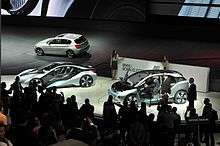
The demand for BMW i and iPerformance vehicles increased significantly during the first half of 2016. In June 2016, 4% of all BMW sales in Western Europe were electrified cars,[33] and again in July 2016, the electrified models captured 4% of all BMW sales in the region.[34] In the Netherlands, 43% of BMW 3 Series registrations in July 2016 corresponded to the plug-in hybrid BMW 330e iPerformance model, and 26% of BMW 2 Series Active Tourer registrations were for the BMW 225xe. Those figures were higher in Scandinavia, with the plug-in hybrid versions accounting for 45% of all BMW 3 Series sales, and 55% of all BMW 2 Series Active Tourer sales.[34] In November 2016, more than one third of total BMWs sales in the Dutch market were electrified models.[35] Sales of BMW plug-in hybrid and i3 electric cars in China totaled 1,796 units during the first nine months of 2016.[36] In July 2016, the i3 achieved a 7.5% share of all BMW passenger car sales in the American market. Accounting for all BMW plug-ins (i3, i8, X5 xDrive40e and 330e) sold in July 2016 (2,375 units), BMW also achieved a 9.2% share of the brand's total passenger and light trucks sales.[37]
Global sales of all plug-in electrified models achieved the 100,000 unit milestone in early November 2016, consisting of more than 60,000 i3s, over 10,000 i8s, and about 30,000 from combined sales of all BMW iPerformance plug-in hybrid models.[15] Combined global sales of BMW’s electrified models totaled more than 62,000 units in 2016,[38] and 103,080 in 2017, including MINI brand electrified vehicles.[39] Cumulative global sales of BMW Group's electrified vehicles passed the 250,000 unit milestone in April 2018.[16]
BMW i3
Design and technology
The BMW i3 is an electric car, BMW's first zero emissions mass-produced vehicle. The i3 is the first volume production vehicle on the market featuring carbon-fiber reinforced plastic.[40] This vehicle gets its power from an electric motor powered by lithium-ion batteries. The i3 is built for everyday use, with an all-electric range of 130 to 160 km (81 to 99 mi). BMW is offering a range extender (“REx”) option powered by a 647 cc two-cylinder gasoline engine with a 9 L (2.0 imp gal; 2.4 US gal) fuel tank that engages when the battery level drops to a pre-specified point, acting purely as a generator to produce electricity to extend the range to about 240 to 300 km (150 to 190 mi).[41]
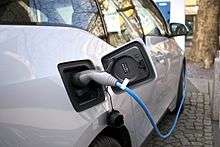
According to BMW, at the beginning of the i3 release, the use of range-extender was much more than the carmaker expected, more than 60%. Over time it has decreased significantly, with some people almost never using it, and by early 2016 it is being regularly used in fewer than 5% of i3s.[42]
In May 2016, BMW announced that the 2017 model year (MY) BMW i3 will come with an improved battery pack with 50% more capacity (33 kWh) than the previous model with a corresponding range increase expected to achieve 114 mi (183 km) under the EPA cycle, and 195 mi (314 km) under the New European Driving Cycle.[31][43] The Range Extender (REx) variant features the same higher capacity battery as the all-electric model, with a corresponding all-electric range increase.[31] Deliveries of the 2017 MY i3 in the U.S. market began in the third quarter of 2016.[44] Both variants with the improved battery are available in the UK starting in July 2016.[43]
Production
BMW invested US$100 million to build a plant in Moses Lake, Washington to manufacture the carbon-fiber reinforced plastic used on the vehicles' body panels.[17] The plant is located in an area that has large access to hydroelectric power.[17] The carbon fiber is then shipped to Germany, where it first gets fabricated and is then shipped to the automotive production plant in Leipzig.[17] In October 2017 the BMW Group reported that the 100,000th BMW i3 had been built.[45]
Markets and sales
The first i3 deliveries to retail customers in Europe took place at the official market launch ceremony held in Munich on 15 November 2013.[6] The i3 was also launched in the UK in November 2013.[46] The release in the American market took place in May 2014.[47] As of November 2015, the core phase of the market introduction of the i3 was finished, with only some smaller markets are still to follow.[13] As of May 2016, the i3 was available in 50 countries.[31]
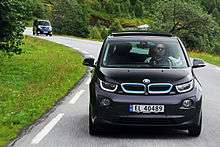
The i3 ranked third among all-electric cars sold worldwide in 2014.[49][50] BMW i3 sales grew from 16,052 units in 2014 to 24,057 in 2015,[51][52] allowing the i3 to rank for the second year in a row as the world's third best selling all-electric car. Also in 2015 the i3 ranked fifth among the world's top selling plug-in electric cars.[53] About 25,500 units were delivered worldwide in 2016, up 6% from 2015, allowing the BMW i3 to rank in 2016 for the third year running as the world's third best-selling all-electric car. In 2016 the i3 also ranked as the fifth top selling plug-in electric car.[14] Global sales totaled 31,482 i3s in 2017.[39] All sales figures include the REx variant.
Since its introduction, global cumulative sales totaled about 65,500 units through December 2016, making the i3 the world's all-time third best-selling all-electric car after the Nissan Leaf and the Tesla Model S. These figure includes REx sales.[14] As of November 2016, the i3 continued as the top selling BMW electrified model, and accounted for 60% of combined BMW i and BMW iPerformance models.[15] As of December 2017, the United States listed as the i3 top selling country market with 31,017 units,[31][54][55][56] followed by Norway with 13,483 new units registered,[57][58][59][60] and Germany with 12,245 units.[61][62][63][64][65] Norway has the world's largest i3 market penetration per capita due to its population size,[48] The BMW i3 ranked as the top selling new passenger car model in Norway in November 2016, capturing a market share of 7.7% of total new car sales.[66][67]
BMW i8
The BMW i8 plug-in hybrid is the production version of the BMW Vision Efficient Dynamics concept unveiled at the 2009 Frankfurt Motor Show and has an all-electric range of 35 kilometres (22 mi). Production of both plug-in electric cars is scheduled to start in Leipzig in 2013.[3] Powering the front wheels will be an electric motor (131 hp), while the rear wheels will make use of a 1.5-litre 3-cylinder gasoline engine (231 hp).[68] Zero to 60 mph sprint timings are estimated to be less than 4.5 seconds using both power sources.[4] The positioning of the motor and engine over the axles also makes it benefit from a 50/50 weight distribution.[68]
_coupe_(25835062172).jpg)
The production version of the i8 was unveiled at the 2013 Frankfurt Motor Show.[69] BMW plans to sell the i8 in about 50 countries, with the U.S. expected to be the largest sales market. In Europe, the UK, Germany and France are expected to be the top markets.[70] Retail deliveries began in Germany in June 2014.[7] Deliveries to retail customers in the U.S. started in August 2014.[71]
As of December 2015, global sales totaled 7,197 i8s, of which, 1,741 units were sold in 2014, and 5,456 in 2015.[51][52] In 2015 global sales of the BMW i8 exceeded the combined figure of all other hybrid sports cars produced by other manufacturers.[72] The United States is the leading market with 4,108 units delivered through October 2016,[73][54][74] followed by the UK with about 1,700 sold through October 2016[75], and Germany with 986 i8s registered through September 2016.[62][63][76] Since mid-2014 more than 10,000 BMW i8s have been sold worldwide by early November 2016, making the i8 the world's top selling plug-in electrified sports cars.[15]
The BMW i8 Roadster concept was unveiled at the 2012 Beijing Auto Show. In October 2016, BMW announced that the roadster variant would be added to the BMW i lineup in 2018. The i8 roadster is expected to get a longer-range battery.[77]
Life-Drive
Both the i3 and i8 will benefit from BMW’s Life-Drive platform which makes use of light-weight materials.[2] Both cars will come with an aluminum chassis, and in the case of the i8, the windshield, top, doors and fenders are made from polycarbonate glass, with the body having a drag coefficient of 0.26.[78]
EPA ratings
The following are the BMW i3 (both 60 and 94 ampere-hour per hour batteries) and i8 U.S. Environmental Protection Agency (EPA) ratings for all-electric range and fuel economy.
| BMW i3 EPA ratings [79][80][81][82] | |||||
| Model | Year model | Fuel/EV range | Combined | City/Highway | Notes |
|---|---|---|---|---|---|
| BEV (94 A·h) | 2017 | 114 mi (183 km) | 118 mpg-e (29 kW-hrs/100 mi) | 129 mpg-e/ 106 mpg-e | |
| BEV (60 A·h) | 2014 2015 2016 | 81 mi (130 km) | 124 mpg-e (27 kW-hrs/100 mi) | 137 mpg-e (25 kW-hrs/100 mi)/ 111 mpg-e (30 kW-hrs/100 mi) | [lower-alpha 1] |
| REx (94 A·h) | 2017 | Electricity only 97 mi (156 km) | 111 mpg-e (30 kWh/100 mi) | - | [lower-alpha 2] |
| Gasoline only 83 mi (134 km) | 35 mpg | - | |||
| REx (60 A·h) | 2014 2015 2016 | Electricity only 72 mi (116 km) | 117 mpg-e (29 kW-hrs/100 mi) | 97 mpg-e/ 79 mpg-e | |
| Gasoline only 78 mi (126 km) | 39 mpg/ 41 mpg | 37 mpg | |||
| BMW i8 EPA ratings [88] | |||||
| BMW i8 | 2014 2015 2016 | Electricity only 15 mi (24 km) | 76 mpg-e (43 kW-hrs/100 mi) | - | [lower-alpha 3] |
| Gasoline only 315 mi (507 km) | 28 mpg | 28 mpg/ 29 mpg | |||
Notes:
| |||||
BMW iPerformance
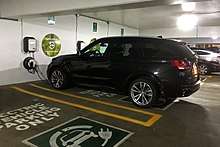
Launched in Europe and the U.S. in 2015, the BMW X5 xDrive40e is the first plug-in hybrid released under the core BMW brand. The use of BMW's eDrive technology on the established X5 platform is a direct technology transfer from the BMW i cars, in particular, from the BMW i8 technology.[9]
In February 2016, BMW announced the introduction of the "iPerformance" model designation, which was given to all BMW plug-in hybrid vehicles from July 2016. The aim is to provide a visible indicator of the transfer of technology from BMW i to the BMW core brand.[8] The first BMW car launched to the market with the "iPerformance" model designation was the BMW 330e iPerformance, initially named the 330e. Deliveries in the American market began in the second quarter of 2016.[89] The new designation was also used on the plug-in hybrid variants of the new BMW 7 Series, the BMW 740e iPerformance.[8] The iPerformance models have a BMW i logo on the front side panel, BMW i-style blue elements in the kidney grille and wheel hubs, and an eDrive logo on the C-pillar.[8]
As of November 2016, four BMW electrified models have been released, the BMW X5 xDrive40e, BMW 225xe Active Tourer, BMW 330e iPerformance, and the BMW 740e iPerformance.[10] The BMW 530e iPerformance is scheduled to be released in Europe March 2017 as part of the upcoming seventh generation BMW 5 Series lineup.[90] The Mini Cooper S E Countryman ALL4 plug-in hybrid was released in June 2017.[91]
Gallery
 BMW i8 concept plug-in hybrid
BMW i8 concept plug-in hybrid_(2).jpg) Production BMW i8 plug-in hybrid
Production BMW i8 plug-in hybrid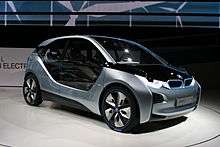 BMW i3 concept electric car
BMW i3 concept electric car- The BMW i3 Concept Coupé exhibited at the 2013 Geneva Motor Show.
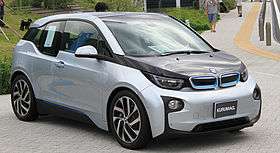 Production BMW i3 all-electric car
Production BMW i3 all-electric car- Production BMW i3 with range-extender (REx) option
.jpg) BMW i Vision Dynamics concept electric car
BMW i Vision Dynamics concept electric car
See also
References
- 1 2 3 Joe Lorio (May 2010). "Green: Rich Steinberg Interview: Electric Bimmer Man". Automobile Magazine. Retrieved 2013-02-13.
- 1 2 3 Phil Patton (2010-07-03). "Envisioning a Small Electric BMW for the World's Very Big Cities". New York Times. Archived from the original on 2013-06-02. Retrieved 2010-07-03.
- 1 2 3 "BMW introduces new i sub-brand, first two vehicles i3 and i8; premium mobility services and new venture capital company". Green Car Congress. 2011-02-21. Retrieved 2011-02-21.
- 1 2 Shaun Bailey (2011-09-13). "BMW i3 Concept - 2011 Frankfurt Auto Show". Road & Track. Archived from the original on 2011-10-07. Retrieved 2011-10-02.
- ↑ Sebastian Blanco (2013-09-18). "BMW i3 starts production in Germany using local wind power, US carbon fiber". Autoblog Green. Retrieved 2013-09-19.
- 1 2 3 Jay Cole (2013-11-15). "BMW Delivers First i3 Electric Vehicles In Germany Today". InsideEVs.com. Retrieved 2013-11-16.
- 1 2 Eric Loveday (2014-06-06). "World's First BMW i8 Owners Take Delivery In Germany". InsideEVs.com. Retrieved 2014-06-07.
- 1 2 3 4 5 "BMW at the 86th Geneva International Motor Show 2016" (Press release). Munich: BMW Group PressClub Global. 2016-02-12. Retrieved 2016-02-12.
- 1 2 Tony Borroz (2015-03-16). "The BMW X5 xDrive40e, a plug-in hybrid SUV from Bavaria". Gizmag.com. Retrieved 2016-02-12.
- 1 2 BMW Group (November 2016). "Electrified by BMW i - BMW iPerformance: Plug-in hybrids with BMW i know-how". BMW.com. Retrieved 2016-11-03.
- 1 2 Cobb, Jeff (2016-02-15). "BMW Sells its 50,000th i-Series Worldwide in January". HybridCars.com. Retrieved 2016-02-16.
- 1 2 Cobb, Jeff (2016-08-01). "Renault Zoe and BMW i3 Join The 50,000 Sales Club". HybridCars.com. Retrieved 2016-08-04.
- 1 2 "The BMW i3 turns two. Time for an interim review. In Germany the BMW i3 has been the best-selling electric car since it was launched. In the worldwide ranking it stands third" (Press release). Munich: BMW Group. 2015-11-12. Retrieved 2015-11-16.
- 1 2 3 4 Cobb, Jeff (2017-01-26). "Tesla Model S Is World's Best-Selling Plug-in Car For Second Year In A Row". HybridCars.com. Retrieved 2017-01-26.
- 1 2 3 4 5 "Three years since the market launch of BMW i. 100,000 electrified BMW on the road" (Press release). Munich: BMW Group Press Club Global. 2016-11-03. Retrieved 2016-11-03. Three year after the market launch of the BMW i3, the BMW Group has delivered more than 100,000 purely electric-powered cars and plug-in hybrids to customers worldwide. The BMW i3 alone has reached more than 60,000 units, making it the most successful electric vehicle in the premium compact segment. The BMW i8 ranks first among electrified sports cars, with more than 10,000 delivered since the middle of 2014. Additionally, there are the approximately 30,000 iPerformance plug-in hybrids sold.
- 1 2 "More than a quarter of a million electrified BMW Group vehicles on the roads after strong April sales growth" (Press release). Munich: BMW Group. 2018-05-15. Retrieved 2018-05-26.
- 1 2 3 4 5 Tom Murphy (2010-05-19). "Mini E Only Beginning of BMW EV Strategy". Wards Auto. Retrieved 2010-06-13.
- ↑ "Mini Says Half of Last Year's Mini E Lessees Renewed for Another Year". Edmunds.com. 2010-05-12. Archived from the original on 2010-05-18. Retrieved 2010-06-12.
- ↑ "BMW's "CO2 Champion" Performance Concept is a Plug-in Diesel Hybrid; 50 km/31 mile All-Electric Range; Thermo-electric Generator for Waste Heat Recovery". Green Car Congress. 2009-08-30. Retrieved 2011-02-21.
- ↑ Jeff Cobb (2015-06-15). "Three More Plug-in Cars Cross 25,000 Sales Milestone". HybridCars.com. Retrieved 2015-06-28.
- ↑ Horatiu Boeriu (2015-07-10). "Worldwide sales of BMW i3 and i8 exceed 30,000 units in 2015". BMWBlog. Retrieved 2015-07-11. A total of 26,205 i3s and 4,456 i8s have been sold worldwide through June 2015. BMW i3 sales totaled 9,846 units during the first half of 2015.
- ↑ Behrmann, Elisabeth (2016-12-04). "BMW Sees Battery Costs Causing Years of 'Tears' on E-Cars". Bloomberg.com. Retrieved 2016-12-07.
the company expects it to take about seven years to double the amount of energy stored in a battery, which weighs about 230 kilograms (510 pounds) in the squat BMW i3 hatchback. “We simply have to walk through the valley of tears” to figure out how to save more money on producing battery-powered cars, [said] Stefan Juraschek, vice president of electric-powertrain development
- ↑ Cremer, Andreas (2016-11-13). "BMW eyes 100,000 electric car sales in 2017: Sueddeutsche". Reuters. Retrieved 2016-11-14.
- ↑ Behrmann, Elisabeth (2016-11-10). "BMW Labor Chief Urges CEO to Accelerate Electric-Car Rollout". Bloomberg.com. Retrieved 2016-12-07.
Mercedes parent Daimler AG and BMW both predict sales in the electric segment -- including plug-in hybrids and battery-only autos -- will account for as much as 25 percent of total deliveries in about 10 years. For BMW, that’s potentially more than half a million cars based on 2015 sales of 2.25 million vehicles, and compares with a 2 percent share of deliveries now.
- ↑ "BMW confirms production of all-electric X3 crossover, i4 sedan by 2020". NY Daily News. 2018-03-22. Retrieved 2018-04-17.
- ↑ https://www.bloomberg.com/news/articles/2016-07-01/bmw-teams-up-with-intel-mobileye-for-self-driving-car-by-2021
- ↑ https://www.caradvice.com.au/691608/bmw-i4-2025/
- ↑ Levent Ozler (2012-06-13). "First BMW i Store Opens in London: New BMW i3 Concept and BMW i Pedelec Concept". Dexigner. Retrieved 2012-06-13.
- ↑ Eric Loveday (2014-12-01). "BMW Commits To Offering Plug-In Hybrid Versions Of All Core-Brand Models". InsideEVs.com. Retrieved 2014-12-02.
- ↑ "BMW Group continues its course of profitable growth" (Press release). Munich: BMW Group. 2016-08-02. Retrieved 2016-08-04.
- 1 2 3 4 5 "The new 2017 BMW i3 (94 Ah): More range paired to high-level dynamic performance" (Press release). Woodcliff Lake, New Jersey: BMW Group PressClub USA. 2016-05-02. Retrieved 2016-05-03. The most important single market for the purely electric five door BMW i3 is the U.S.
- ↑ Cremer, Andreas (2016-11-13). "BMW eyes 100,000 electric car sales in 2017: Sueddeutsche". Reuters. Retrieved 2016-11-14.
- ↑ "BMW Group sales achieve best-ever June result" (Press release). Munich: BMW Group Global. 2016-07-12. Retrieved 2016-07-14.
- 1 2 "BMW Group sales grow steadily for best-ever July" (Press release). Munich: BMW Group Global. 2016-08-10. Retrieved 2016-08-20.
- ↑ "BMW Group sales achieve record November" (Press release). Munich: BMW Group Global. 2016-12-12. Retrieved 2016-12-14.
- ↑ Parkin, Brian; Jennen, Birgit (2016-11-03). "German Minister Snubs Automakers to Back China EV Quota Plan". Bloomberg News. Retrieved 2016-11-04.
- ↑ Kane, Mark (2016-08-20). "BMW Sells 1 Of 10 Vehicles With A Plug In July For US, Surprises With Nearly 1,500 Sales i3 Sales". InsideEVs.com. Retrieved 2016-08-20.
- ↑ "BMW Group achieves sixth consecutive all-time sales high and remains world's leading premium car company" (Press release). Munich: BMW Group Global. 2017-01-09. Retrieved 2017-02-25.
- 1 2 "Record sales for BMW Group worldwide during 2017 while it boosts the Premium car market in Mexico, Latin America and the Caribbean" (Press release). Mexico City: BMW Group. 2018-01-25. Retrieved 2018-02-16. The BMW Group delivered a total of 103,080 plug-in electric cars in 2017 worldwide, including MINI plug-in hybrid models. Of these, 31,482 were i3s.
- ↑ "BMW Group: Megacity Vehicle to launch in 2013". BMW (press release). 2010-04-22. Retrieved 2010-08-03.
- ↑ Jay Cole (2013-07-29). "BMW i3 Range Extender To Offer Up to 87 More Miles, Decreases Performance". InsideEVs.com. Retrieved 2013-07-29.
- ↑ Duff, Mike (2016-03-08). "BMW i Chief: Larger i Models Will Offer Optional Range-Extender". Car and Driver. Retrieved 2016-03-18.
- 1 2 Lilly, Chris (2016-05-02). "New BMW i3 gets 195 mile range". Next Green Car UK. Retrieved 2016-05-04.
- ↑ Siler, Steve (May 2016). "2017 BMW i3: Now with More Electric Range". Car and Driver. Retrieved 2016-05-04.
- ↑ Kane, Mike (2017-10-28). "Major Milestone: BMW i3 #100,000 Rolls Off Assembly Line". insideevs.com. Retrieved 2017-11-01.
- ↑ BMW Group (2013-11-06). "The new BMW i3 - Press pack". BMW Group Press Club UK. Retrieved 2013-11-07.
- ↑ Eric Loveday (2014-05-02). "BMW Announces Delivery Of First US i3". InsideEVs.com. Retrieved 2014-05-02.
- 1 2 Luca Ciferri (2014-06-06). "BMW sales boss bullish on 'born electric' range". Automotive News Europe. Retrieved 2014-06-11.
- ↑ "Statement and presentation by Dr. Norbert Reithofer, Chairman of the Board of Management of BMW AG, Annual Accounts Press Conference in Munich on 18 March 2015" (Press release). Munich: BMW Group. 2015-03-18. Retrieved 2015-03-21.
- ↑ Jeff Cobb (2015-02-10). "2014's Top-10 Global Best-Selling Plug-in Cars". HybridCars.com. Retrieved 2015-03-21. A total of 16,052 i3s were sold in 2014, with global cumulative sales since their introduction totaling 17,529 units through the end of 2014.
- 1 2 "BMW Group sells more than 2 million vehicles in 2014" (Press release). Munich: BMW Group PressClub Global. 2015-01-09. Retrieved 2015-01-10. A total of 16,052 i3s and 1,741 i8s were sold in 2014.
- 1 2 "BMW Group achieves fifth consecutive record sales year" (Press release). Detroit/Munich: BMW Group. 2016-01-11. Retrieved 2016-01-17. A total of 29,513 BMW i brand units were delivered to customers worldwide in 2015, up 65.9% from 2014, consisting of 24,057 BMW i3s and 5,456 BMW i8s.
- ↑ Cobb, Jeff (2016-01-12). "Tesla Model S Was World's Best-Selling Plug-in Car in 2015". HybridCars.com. Retrieved 2016-01-23. The Tesla Model S was the top selling plug-in electric car in 2015 (50,366), followed by the Nissan Leaf (about 43,000), the Mitsubishi Outlander P-HEV (about 39,000), the BYD Qin (31,898) and the BMW i3 (24,057).
- 1 2 Jeff Cobb (2016-01-06). "December 2015 Dashboard". HybridCars.com and Baum & Associates. Retrieved 2016-01-17.
- ↑ Cobb, Jeff (2017-01-05). "December 2016 Dashboard". HybridCars.com and Baum & Associates. Retrieved 2017-02-19.
- ↑ Cobb, Jeff (2018-01-04). "December 2017 Dashboard". HybridCars.com and Baum & Associates. Retrieved 2018-02-17.
- ↑ Norwegian Road Federation (OFV) (January 2014). "CO2-utslippet i desember 2013" [CO2 emissions in December 2013] (in Norwegian). OFV. Retrieved 2016-01-17. A total of 51 new i3s were registered in Norway in 2013.
- ↑ Norwegian Road Federation (OFV) (January 2015). "CO2-utslippet i desember 2014" [CO2 emissions in December 2014] (in Norwegian). OFV. Retrieved 2015-02-14. See graph: Gjennomsnittlig CO2-utslipp for registrerte ney personbiler per modell 2014, til og med desember. A total of 2,040 BMW i3s were registered in Norway in 2014.
- ↑ Norwegian Road Federation (OFV) (January 2016). "Bilsalget i 2015" [Car sales in 2015] (in Norwegian). OFV. Retrieved 2016-10-23. A total of 2,403 new i3s, including the REx variant, were registered in Norway in 2015.
- ↑ Opplysningsrådet for Veitrafikken AS (OFV). "Bilsalget i 2017" [Car sales in 2017] (in Norwegian). OFV. Retrieved 2018-02-17.
- ↑ Kraftfahrt-Bundesamtes (KBA) (January 2014). "Neuzulassungen von Personenkraftwagen im Dezember 2013 nach Segmenten und Modellreihen" [New registrations of passenger cars in December 2013 by segment and model series] (PDF) (in German). KBA. Retrieved 2014-05-10. A total of 559 units were registered in Germany in 2013.
- 1 2 Kraftfahrt-Bundesamtes (KBA) (January 2015). "Neuzulassungen von Personenkraftwagen nach Segmenten und Modellreihen im Dezember 2014" [New registrations of passenger cars in December 2014 by segment and model] (PDF) (in German). KBA. Archived from the original (PDF) on 2015-02-05. Retrieved 2015-01-27. A total of 2,233 i3s and 400 i8s were registered in Germany in 2014.
- 1 2 Kraftfahrt-Bundesamt (KBA) (January 2016). "Neuzulassungen von Personenkraftwagen nach Segmenten und Modellreihen im Dezember 2015" [New registrations of passenger cars by segments and models in December 2015] (PDF) (in German). KBA. Archived from the original (PDF) on 2016-01-10. Retrieved 2016-01-17. A total of 2,271 i3s and 393 i8s were registered in Germany in 2015.
- ↑ Pontes, Jose (2017-01-16). "Germany December 2016 (Updated)". EVSales.com. Retrieved 2018-01-14.
- ↑ Kraftfahrt-Bundesamt (KBA) (January 2018). "Neuzulassungen von Personenkraftwagen nach Marken und Modellreihen im Dezember 2017 (FZ 10) (XLS, 153 KB, Datei ist nicht barrierefrei)" [New registrations of passenger cars by segments and models in December 2016] (in German). KBA. Retrieved 2018-02-04. Click on the link Neuzulassungen von Personenkraftwagen nach Marken und Modellreihen im Dezember 2017 (FZ 10) (XLS, 153 KB, Datei ist nicht barrierefrei) to download the file with registrations figures.
- ↑ Norwegian Road Federation (OFV) (2016-12-01). "Bilsalget i november" [Car sales in November] (in Norwegian). OFV. Retrieved 2016-12-03. Click on "Modellfordelt" to display the top 20 selling new cars in Norway: BMW i3 registrations totaled 3,540 units during the first eleven months of 2016
- ↑ Hegvold, Ola (2016-12-02). "BMW med elbil-sjokk i november" [BMW with electric vehicle shock in November]. Adressa (in Norwegian). Retrieved 2016-12-03.
- 1 2 BMW Group (2013-08-07). "BMW Group presents prototype of i8 plug-in hybrid; first use of new 3-cylinder engine". Green Car Congress. Retrieved 2013-08-08.
- ↑ Anita Lienert (2013-08-02). "2015 BMW i8 Set for Debut at 2013 Frankfurt Auto Show". Edmunds.com. Retrieved 2013-08-06.
- ↑ Pia Krix (2013-08-09). "BMW sees U.S., UK, Germany as top markets for i8". Automotive News Europe. Retrieved 2013-08-11.
- ↑ Eric Loveday (2014-08-16). "BMW Delivers First US i8". InsideEVs.com. Retrieved 2014-08-16.
- ↑ Bruce, Chris (2016-02-12). "Protonic Red BMW i8 will bow in Geneva". Autoblog.com. Retrieved 2016-02-13. See details in the original BMW press release.
- ↑ Jeff Cobb (2015-01-06). "December 2014 Dashboard". HybridCars.com and Baum & Associates. Retrieved 2015-01-10. See section "December 2014 Battery Electric Car Sales Numbers"
- ↑ Cobb, Jeff (2016-11-02). "October 2016 Dashboard". HybridCars.com and Baum & Associates. Retrieved 2016-11-04.
- ↑ "BMW i8 and i3 showcased in the capital" (Press release). London: BMW Group PressClub United Kingdom. 2016-11-04. Retrieved 2016-11-06.
- ↑ Kraftfahrt-Bundesamt (KBA) (October 2016). "Neuzulassungen von Personenkraftwagen im September 2016 nach Segmenten und Modellreihen" [New registrations of passenger cars by segments and models in September 2016] (PDF) (in German). KBA. Retrieved 2016-11-04. A total of 1,748 i3s and 193 i8s were registered in Germany between January and October 2016.
- ↑ Sage, Alexandria (2016-10-14). "BMW will add plug-in hybrid i8 roadster in 2018". Reuters. Automotive News Europe. Retrieved 2016-10-23.
- ↑ Hong, Patrick (2010). "Future Vision". Road & Track. 61 (7): 40–45.
- 1 2 United States Environmental Protection Agency and U.S. Department of Energy (2014-07-04). "Compare Side-by-Side: 2014 BMW i3 BEV & 2014 BMW i3 REx". fueleconomy.gov. Retrieved 2014-07-04.
- 1 2 U. S. Environmental Protection Agency and U.S. Department of Energy (2016-11-16). "Fueleconomy.gov's Top Fuel Sippers (EPA Ratings, 2017 Model Year)". fueleconomy.gov. Retrieved 2016-11-21. Excludes all-electric vehicles. Click on the tab "EPA Rated – All Years. The 2013–2014 Chevrolet Volt has a combined fuel economy of 62 MPG-e.
- 1 2 United States Environmental Protection Agency and U.S. Department of Energy (2014-08-20). "Model Year 2014 Fuel Economy Guide - Electric vehicles & Plug-in Hybrid Electric Vehicles (updated August 2014)" (PDF). fueleconomy.gov. Retrieved 2014-08-26. pp. 33 and 36
- ↑ United States Environmental Protection Agency and U.S. Department of Energy (2016-09-29). "Compare Side-by-Side: 2015 BMW i3 REX, 2016 BMW i3 REX, 2017 BMW i3 REX (94 Amp-hour battery), and 2017 BMW i3 BEV (94 Amp-hour battery)". fueleconomy.gov. Retrieved 2016-09-30.
- ↑ U. S. Environmental Protection Agency and U.S. Department of Energy (2016-11-16). "Most Efficient EPA Certified Vehicles". fueleconomy.gov. Retrieved 2016-11-19. The 2014–16 BMW i3 BEV was the most efficient EPA-certified vehicles considering all fuels and of all years until November 2016, when it was surpassed by the 2017 Hyundai Ioniq Electric. As of November 2016, the 2016 Toyota Prius Eco hybrid car is most efficient EPA-certified vehicle with a gasoline engine without plug-in capability.
- ↑ Edelstein, Stephen (2016-11-21). "Hyundai Ioniq Electric beats Prius Prime, BMW i3 on energy efficiency". Green Car Reports. Retrieved 2016-11-21.
- ↑ United States Environmental Protection Agency and U.S. Department of Energy (2016-11-16). "Model Year 2017 Fuel Economy Guide - Electric vehicles & Plug-in Hybrid Electric Vehicles" (PDF). fueleconomy.gov. Retrieved 2016-11-19. pp. 32–36.
- ↑ John Voelcker (2014-05-01). "2014 BMW i3 Electric Car Rated At 81 Miles, 124 MPGe: BREAKING". Green Car Reports. Retrieved 2014-05-01. See details in EPA window sticker.
- ↑ John Voelcker (2014-05-02). "2014 BMW i3 Range-Extended Model Gets Full $2,500 CA Rebate For Electric Cars". Green Car Reports. Retrieved 2014-05-02.
- ↑ U.S. Environmental Protection Agency and U.S. Department of Energy (2014-08-21). "2014 BMW i8". Fueleconomy.gov. Retrieved 2014-08-22.
- ↑ Millikin, Mike (2016-03-22). "BMW prices 330e iPerformance PHEV in US starting at $44,695; 14 miles AER". Green Car Congress. Retrieved 2016-04-12.
- ↑ Cole, Jay (2016-10-13). "BMW 530e iPerformance Debuts, Arrives In March – Specs, Video". InsideEVs.com. Retrieved 2016-10-18.
- ↑ "BMW Group sales achieve best-ever start to the year" (Press release). London: BMW Group PressClub United Kingdom. 2017-02-10. Retrieved 2017-02-25.
External links
| Wikimedia Commons has media related to BMW i. |
- Video
- BMW i3. From the first idea to the final car, BMW, July 2014 (YouTube)
« previous — BMW cars: 2000s to 2010s | |||||||||||||||||||||||||||||||||||||||
|---|---|---|---|---|---|---|---|---|---|---|---|---|---|---|---|---|---|---|---|---|---|---|---|---|---|---|---|---|---|---|---|---|---|---|---|---|---|---|---|
| Series | 2000s | 2010s | |||||||||||||||||||||||||||||||||||||
| 0 | 1 | 2 | 3 | 4 | 5 | 6 | 7 | 8 | 9 | 0 | 1 | 2 | 3 | 4 | 5 | 6 | 7 | 8 | |||||||||||||||||||||
| 1 Series | E87 | F20 | |||||||||||||||||||||||||||||||||||||
| E82 | F52 | ||||||||||||||||||||||||||||||||||||||
| 2 Series | F22 | ||||||||||||||||||||||||||||||||||||||
| F45 | |||||||||||||||||||||||||||||||||||||||
| 3 Series | <<E46 | E90 | F30 | ||||||||||||||||||||||||||||||||||||
| 4 Series | F32 | ||||||||||||||||||||||||||||||||||||||
| 5 Series | <<E39 | E60 | F10 | G30 | |||||||||||||||||||||||||||||||||||
| 6 Series | E63 | F12 | G32 | ||||||||||||||||||||||||||||||||||||
| 7 Series | <<E38 | E65 | F01 | G11 | |||||||||||||||||||||||||||||||||||
| 8 Series | G15 | ||||||||||||||||||||||||||||||||||||||
| Z Series | <<Z3 | E85 | E89 | G29 | |||||||||||||||||||||||||||||||||||
| <<Z8 | |||||||||||||||||||||||||||||||||||||||
| i3 | I01 | ||||||||||||||||||||||||||||||||||||||
| i8 | I12 | ||||||||||||||||||||||||||||||||||||||
